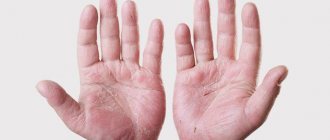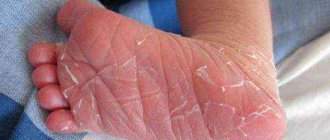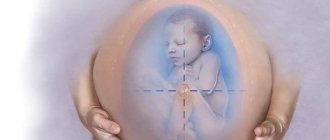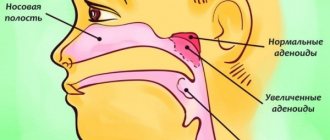On TV screens and in glossy magazines we often see beautiful, plump babies with soft pink skin. Therefore, it has been ingrained in our minds that a healthy baby should have an attractive epidermis of a uniform, pleasant shade. But is it worth panicking if your newborn baby’s skin looks different, and as soon as the little one starts crying, the body generally takes on a reddish-bluish uneven color?
Let's try to understand this difficult matter and find out why a newborn baby has marbled skin and whether it is worth treating.
What does marble skin mean?
The main feature of this skin color is the presence of a peculiar spotted or marbled tint on it. This occurs due to the location of the smallest vessels close to the skin. Some of them may narrow, causing the skin to turn bluish. Some vessels dilate, so in the place where this occurs, the epidermis turns red. As a result of uneven narrowing or expansion of capillaries, a characteristic pattern is formed on the skin of the baby.
In normal cases, marbling appears throughout the body. In others, the characteristic mesh becomes visible in one place, for example, on the cheeks or arms.
Important! Marble-like skin coloring in newborns is not a painful condition. Its appearance is explained by the unstable functioning of the vegetative-vascular system.
A peculiar coloration of the epidermis in a newborn girl or boy is not always a pathology. It may be a natural condition of the skin.
Livedo: classification
Marbling is divided into several classes:
- Livedo racemosa - occurs more often in women, the pattern resembles trees with branches.
- Livedo reticularis a frigore is the main cause of dermatitis or cold. The spots are bluish in color, located on the sides, and disappear when pressed.
- Livedo reticularis a calore – appears due to high temperatures, heating. The skin first turns red, and then a pattern is drawn.
- Livedo lenticularis – for tuberculosis. Pale blue mesh.
Why does marbling happen?
The causes of marbled skin in infants vary. When diagnosing, doctors take into account all its manifestations.
Physiological features
Leukocytes in the stool of a child under one year old - the norm, reasons for the increase
Physiological factors that contribute to the appearance of a characteristic skin tone in infants include the following:
- thin and light skin;
- a small layer of subcutaneous fat;
- prolonged crying;
- prematurity;
- hypothermia, caused, in particular, by swimming in insufficiently heated water;
- vascular injury during childbirth;
- non-compliance with feeding rules;
- body features.
Note! Usually, by the age of six months, not a trace remains of the child’s marbled body color. By this time, blood circulation in the vessels is normalized, and subcutaneous fatty tissue increases in volume.
Normal baby skin
Pathological factors
The pathological causes of the marbled tint of the epidermis include the following:
- Bacterial infections. In this case, the body temperature rises and the blood vessels spasm.
- Oxygen deficiency (hypoxia) during intrauterine development.
- Anemia.
- Jaundice.
Jaundice in a baby
- Congenital heart defect.
- Unfavorable genetic predisposition.
- Malformation of veins.
- Brain cyst.
Rare causes
Rare causes of marbled skin tone include Edwards or Down's disease. In these children, the skin acquires a light pattern from time to time.
Rarely, a baby may have skin marbling syndrome. With this hereditary disease, blood vessels are affected and severe brain pathologies can develop.
Complication of fever
Sometimes marbled skin can appear due to an increase in body temperature to 37, sometimes 38-39 degrees. This is an alarming symptom; if it occurs, you should consult a doctor. This must be done if you experience high fever, chills, vomiting or convulsions.
Sometimes a child may be diagnosed with “white fever”. In this condition, high temperature is combined with constriction of peripheral vessels. The extremities are cold from time to time.
White fever in a baby
How to treat signs of marbling
Marbled skin in a baby, the causes of which cannot be determined without the participation of a doctor, in some cases does not require treatment. If marbling is caused by physiological factors, then with a high probability it will go away on its own as the growing person grows older.
You can accelerate the formation of the vegetative-vascular system with the help of:
- daily rubbing of the limbs of the child’s body (the parent strokes the baby’s arms and legs with intensive circular movements for 10-15 minutes, while making sure that the baby feels comfortable);
- spend as much time outdoors as possible (regardless of weather conditions);
- contrast shower;
- normalization of the child’s eating and sleeping schedule.
If the pathology in question is a consequence of progressive diseases, doctors prescribe treatment taking into account the child’s diagnosis. This can be either surgical intervention (relevant for dysfunctions of the cardiovascular system) or medication adjustment of the health status of a small patient.
The most commonly prescribed medications to eliminate marbling in children are:
- vascular drugs;
- multivitamins that improve blood microcirculation.
The prescription of drugs should be based only on the results of a general blood test, a general urinalysis and the required diagnostic tests. Otherwise, taking incorrectly prescribed medications may not only not relieve the baby of marbling, but also aggravate his general health.
Is it necessary to treat marbling of the skin?
When the diagnosis establishes that the marbled tint of the epidermis appears for natural reasons, then there is no need to treat the baby. It is necessary to eliminate the influence of factors leading to the appearance of a specific symptom. For this it is recommended:
- avoid overheating or excessive cooling, as well as intense crying;
- ensure an acceptable temperature in the room where the baby is staying;
- ventilate the room;
- do wet cleaning;
- dry the baby after bathing with a soft towel;
- massage your arms and legs.
Hand massage for baby
Note! Early swimming will be very beneficial for your child. It can be started even if the baby is less than a month old. Such small children can swim with a circle around their necks.
Symptoms in children of different ages
In young children, marbled skin appears as a red-blue mesh pattern covering the surface of the arms and legs (or the entire body).
When should parents be wary if they notice such a strange coloring on their child, and when should they not worry? You should suspect something is wrong when such patterns persist on the body throughout the entire time or are accompanied by other phenomena uncharacteristic for a healthy child. Warm baths and warming massages do not contribute to their disappearance. In this case, it is necessary to consult a doctor to look for a reason other than the physiological failure of blood vessels and thermoregulation.
When to go to the doctor
Parents should visit a doctor quickly when unnaturally colored skin does not go away as they get older or after warming up. You also need to consult a pediatrician if:
- a bluish tint of the nasolabial triangle is detected;
- there is increased sweating;
- pale skin;
- body temperature rises or falls;
- the child is overexcited or lethargic;
- The baby lies with his head thrown back.
Note! Under no circumstances should you self-medicate or use any tablets, ointments or creams. This is harmful to the baby's health.
Prevention
The key to health at all times and in all cases is considered to be proper balanced nutrition of the child, regular exposure to fresh air, and maintaining the child’s normal emotional state. You should do regular exercises with your little one, and if necessary, take a course of massage prescribed by your doctor. Swimming is a good way to prevent the occurrence of marbled skin and other abnormalities.
Interesting facts, advice from Komarovsky
Here are some facts about marbling of a baby's skin:
- it may appear after strong crying;
- in 2% of cases, marble-like skin may appear after a year, even up to 3 years;
- in the same number of children it is not possible to detect the true cause of the change in skin tone;
- unnatural coloring occurs when overfeeding.
Komarovsky is convinced that marbled skin appears in all babies. This means there is no need to panic about it. In most cases, parents of children under 4 months of age do not need to see a doctor. If marbling persists after the baby reaches four months of age, the child is referred to a pediatric specialist. Parents should follow his advice.
Marbled skin in a baby is normal or may be a sign of a serious illness. If the baby’s condition sharply worsens, a pediatrician’s consultation is necessary. After appropriate diagnosis, you can find out the true reason for the change in the shade of the baby’s skin.
Basics of helping a child at home
Long walks are a method of preventing skin marbling.
Absolutely any parents want their child to recover as quickly as possible in the process of treating the disease or its symptoms.
It is quite easy to deal with marbling of a baby’s skin at home. If you have any concerns or general questions, you can always seek advice from your pediatrician.
home prevention purposes , parents should adhere to the following recommendations:
Carrying out regular massages for a general strengthening effect on the child’s body.
Therapeutic gymnastics classes selected by a specialist during examination.
Bathing the baby in baths with added saline or pine solution. Such procedures have a beneficial effect on the vessels and capillaries of the growing organism.
In addition, they relieve irritation and have a calming effect.
Introducing the necessary complementary foods into the diet, taking into account the child’s age.
Long walks with your baby in the fresh air. However, it is necessary to dress the child according to the season to prevent hypothermia or overheating.
It turns out that the process of lifestyle correction will reduce the factors responsible for the appearance of marbled skin. All the proposed recommendations will help reduce anxiety in both parents and the baby.
In addition, the body will improve blood circulation and the tone of the vascular system, which is a favorable factor in the formation and development of infants and promotes hardening from an early age.
Treatment
Depending on the method of treatment, the following measures for the treatment of livedo are distinguished:
- Medicinal – use of medications (calcium containing preparations, nicotinic acid, vitamin C).
If at this stage the signs of pathology disappear, it means that the reasons were associated with impaired blood supply to its tissues. - Physiotherapeutic – special skin massages and medicinal baths are used to improve blood circulation.
- Hardware - specific therapies (laser, magnetic) are used to restore deep tissues.
In the age of high technology and developed medicine, reticular asphyxia can be controlled and not threaten the vital functions of the body, but, of course, for this it is necessary to regularly consult with specialists and follow all their instructions.
Diagnostics
Primary diagnosis begins with a thorough examination of the appearance of the patient's skin. Then, in 90% of cases, a person who contacts a specialist is sent for tests to exclude or identify deviations from the norm.
Based on the test results and visual examination, the specialist prescribes treatment.
In modern medicine there are many methods for diagnosing reticular asphyxia, for example:
- Study and analysis of the patient's heredity.
- X-ray of the performance area of the marble mesh. With the disease marbling of the skin, the bones become denser and appear opaque in the image.
- A blood test to determine the amount of phosphorus, calcium and ions in its composition, as well as a general blood test.
- Undergoing MRI and computed tomography. Such an examination shows the degree of tissue damage in each layer and states the level of sclerosis.
- Prenatal diagnosis.
What are the reasons for this effect in an adult?
In adults, skin with a marbled pattern is almost always the subject of a doctor’s observation, since in adulthood a violet visible layer of blood vessels, or livedo in other words, cannot be the norm. Often this manifestation is associated with the presence of some negative processes in the body.
Reticular asphyxia appears for a number of reasons:
- Marbling of the skin.
- Developmental deviations.
- Sneddon syndrome is a relationship between vasculitis and systemic vascular diseases such as stroke. This syndrome occurs due to certain genetic diseases.
Marbling of the skin in an adult can be caused by a number of external and internal factors. Depending on them, several types of this condition are distinguished. The syndrome of marbled skin pattern or livedo in people of mature age is caused by a number of factors:
- Livedo racemose. The presence of this syndrome is often caused by one of the serious concomitant diseases: tuberculosis, syphilis, atherosclerosis, malaria, etc. Due to disruptions in the functioning of body systems, the vessels react with a protruding, branching purple mesh.
In advanced stages of the disease, the marble pattern spreads over the entire surface of the skin. If the patient's body cools, the purple spotting appears brighter. - Livedo lenticularis. Concomitant illness of tuberculosis. The manifestation is localized on the shins in the form of pale blue streaks. If the color of the spots intensifies, necrotic formations are possible.
- Livedo reticularisa frigore. A form of marbling of the skin that does not require concern. Characteristic spots appear when the temperature drops and disappear when pressed.
- Livedo reticularis a calore. In some cases, the body may react with a marbling pattern when the body overheats. Warming devices such as heating pads that dilate capillaries can provoke a similar reaction.
The nature of the appearance of reticular asphyxia in a teenager is the same as in older people. The effect of marble skin can cause a disorder of the central nervous system, vegetative-vascular dystonia, neoplasms in the form of cysts or dropsy.
If we summarize all the causes of livedo in adults, then three main factors stand out:
- a sharp increase or decrease in body temperature;
- failure of blood circulation through the vessels;
- concomitant symptom of serious diseases.
Reticular asphyxia as a separate disease has not been studied.
On hands
The simplest option for marbled hand skin is an excess of UV radiation reaching the skin, vasodilation, for example, after a bath, or hypothermia of the skin. On the hands and palms, marbling is expressed by an openwork purple pattern.
This manifestation mainly affects people after 60 years of age. Smokers or people who consume other chemicals that constrict blood vessels are also susceptible to this disease.
Nicotine prevents blood vessels from dilating and blood does not circulate fully, which causes marbling of the skin.
On foot
The feet, legs and thighs are very often susceptible to reticular asphyxia, although it can appear in any area, regardless of the person’s age. A protruding mesh pattern “decorates” the legs in case of vascular dysfunction, possibly lupus, or low platelet levels.
On the face
Weakened blood vessels in the face can lead to butterfly rashes and a marbled appearance on the face.
Rare causes of marbled coloring
The rarest cause is skin marbling syndrome. This is a congenital disease that is associated with an abnormal development of blood vessels. Over the past 40 years, about 210 cases of birth of children with this pathology have been registered in the world.
Symptoms noticeable immediately after birth:
- very large nevi;
- asymmetry of arms and legs, head and body;
- microcephaly of the brain;
- brain diseases;
- malfunction of the central nervous system.









